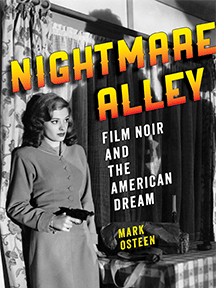By Louis J. Kern
In his critical study of a group of dark, psychologically fraught films with doomed antiheroic protagonists, Osteen examines noir vehicles from They Drive by Night (1941) to Odds Against Tomorrow (1959). Denominated films noir by French critics Nino Frank and Jean-Pierre Chartier in 1946, a term initially used to describe a stylistically discrete sub-genre of American gangster/crime films, the first book-length study of noir, Raymond Borde and Etienne Chaumerton’s Panorama du Film Noir Américain, 1941-1953, did not appear until 1966. Osteen’s work focuses on the cultural Zeitgeist of the post-war U.S. and the Cold War years from a strongly Freudian perspective, analyzing these films under coherent categories—nightmares and dream interpretation, amnesia and loss of identity, problems of returning veterans, portraits and artistic milieux, automobiles and road narratives, jazz and musical subcultures, women and gender roles, and class conflict, capitalism, and progressive politics. Produced in a period of disorienting political uncertainty and social anomie, Osteen argues that noir films “test and critique both the principles of the American Dream—individualism and self-determination, liberty, equality, upward mobility, capitalist enterprise—and their practice.”
Osteen’s discussion of individual films is balanced and penetrating as is his astute use of manuscript material from the Margaret Herrick Library to illuminate the auteur role of specific directors and scriptwriters. Analysis of class and gender is convincing: Osteen stresses that contrary to the notion of the post-war period as one of socioeconomic comity and prosperity, 1945-1946 witnessed the greatest incidence of strikes in U.S. history, a failure of social mobility reflected in the noir world; and contra the domestic mythos of the 1950s over 75 percent of women continued to work after the war, and noir women were less depicted misogynisticly as femmes fatales and more as ”femmes vital,” a depiction enhanced by the women who wrote, produced, and occasionally directed these movies.
Issues of race are less directly addressed, perhaps due to the ironically pallid whiteness of the noir world. Osteen points out the blackness below the surface, especially in the jazz-oriented films, but that observation could have been fruitfully extended to address the white appropriation of blackness that Norman Mailer probed in “The White Negro: Superficial Reflections on the Hipster” (1957). Typically, however, racial themes are subsumed and can be read only as analogues of the diegetic narrative. In Try and Get Me! (1950), for example, the lynching of kidnappers by a media-crazed mob cannot fail but reflect the history of sadistic racial vigilantism. Likewise, the conservative undertones of that film that suggest that poverty and social alienation lead to crime mirror the arguments about the social circumstances of young black men then and now as an explanation for the disproportionate numbers of black prison inmates.
In some places Osteen’s thematic focus occasionally leads to typological problems. In the jazz noirs chapter, the scores and theme songs he discusses are frequently pop songs or blues rather than true jazz. In the femmes vital chapter, some of the films—Caged (1950), Possessed (1947), and Not Wanted (1949) are more properly social problem films dealing with imprisonment, insanity, and unwed motherhood, respectively.
Osteen makes a strong case for noir films as vehicles for the moral and ideological challenge to rampant capitalism and unregulated corporate greed as well as the mordant interrogation of the of the premises of the American Dream—universal opportunity and widespread social mobility—as written and directed by progressive filmmakers. His discussion of the betrayal of the American Dream as the promise of liberty and in particular freedom of speech as reflected by the HUAC hearings and Hollywood blacklisting is pointed and powerful, though his claim that Lloyd Bridges was a “former communist” overstates the case since Bridges was a member of the Actors’ Lab (the center of communist activity in Hollywood in the 1940s) but was cleared by the FBI.
Despite minor issues, Osteen has given us a fresh, discerning, and nuanced perspective on a popular style of Hollywood films during the period 1940-1960 and has proved a reliable guide down the sinuous twistings of “Nightmare Alley.”
Louis J. Kern (ΦBK, Clark University,1965) is Professor of History Emeritus at Hofstra University. Hofstra University is home to the Omega of New York Chapter of Phi Beta Kappa.




